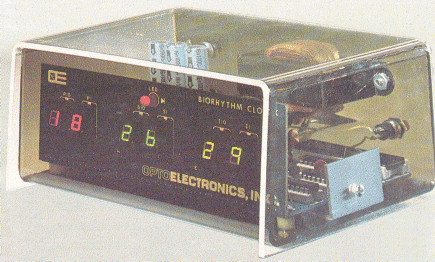 A construction article for the Optoelectronics Biorhythm Clock
appeared in the November 1977 issue of Radio-Electronics magazine.
A construction article for the Optoelectronics Biorhythm Clock
appeared in the November 1977 issue of Radio-Electronics magazine.
|
|
To determine the initial settings for the digits, you have to determine the
number of days from your birth to the present and divide by 23, 28 and 33
to obtain your personal "P", "S" and "I" curve position for that day. Once
this information is entered in the Biorhythm Clock, one count is automatically
added each that is even correct on leap years all the way to 2000 and beyond.
To count the total number of full days you've been alive, start with the full years since your birth date and multiply by 365. Add the number of leap year days during those years, every year divisible by 4 (such as 1976) is a leap year, except for years divisible by 100, such as 1800 and 1900. However, years divisible by 400, such as 2000, are leap years. This compensates for the difference between the length of the common and astronomical years. Now add the days of each full month, being careful to get the right number of days in each month. Add to this the number of days in the parts of a month. You now have a total days figure, excluding the setting day, which will be added in the setting procedure. Divide by 23, the result will be a full number and a remainder. The full number represents the completed cycles you've already experienced; the remainder is yesterday in your present cycle. Enter this remainder on the "P" (red) digits. Do the same for the "S" (green) curve by dividing by 28, and divide by 33 to obtain the "I" (yellow) count entry. For example, suppose today is July 2, 1977, and you were born July 23, 1927. Start by calculating the number of days in the full years: 1928 - 1976, inclusive - 49 years × 365 &eq; 17,885 days. Next come the leap year days: 49 divided by 4 equals 12 days (eliminate the remainder). Now calculate the number of days in the full months between the day you were born and January 1, 1928 (the beginning of the first full year): 153 days (August through December). Don't forget to add the number of days in the full months between the last full year and today's date: 181 days (January through June). Lastly, calculate the number of days in the partial months between the day you were born and the last full month: 9 days (July 23, 1927 and July 31, 1927). Don't forget the number of days between the last full month and today's date: 1 (July 1, 1977). Add all the days and you will discover that you have been alive 18,241 days. Note that the total number of days is one less than the actual number of days of your life, since the day of setting was not included. This is the number you must use, since you will add one day when you set the clock. Now, divide 18,241 by 23, 28 and 33. Since 18,241 divided by 23 is 793 with a remainder of 2, the "P" initial setting is 2. (Note: If you use a calculator, the answer is 793.08695. Multiply the decimal portion by the divisor - in this case 23 - which gives .08695 × 23 &eq; 1.99985, or 2 days.) Similarly, dividing 18,241 by 28 gives an "S" setting of 13, and dividing by 33 yields an "I" setting of 25. Set these "P", "S" and "I" numbers into the Biorhythm Clock, remembering to press and release the setting switch only when the blinking LED is off, or the digits will jump ahead. If this happens, just repeat the operation. Each pair of digits are set separately, and do not interact with any other pair. If the digits do not advance when the pushbuttons are pressed and the LED stays on, this means the clock IC alarm pin is active, grounding the 7490 unit counters through transistor Q1. Just hold down the FAST pushbutton for two or three seconds to clear this condition. Now you must decide the time your want your digits to advance each day - midnight, noon, 8 AM? The choice is up to you, but around midnight is the most usual time. The time you choose determines the next and final steps in setting the clock. Hold the FAST pushbutton down until all three digit pairs advance simultaneously. THis could take as long as 23 seconds, depending on the random turn-on clock IC alarm and real-time settings (Since these settings cannot be read, no control is provided.) Activating the FAST switch causes the clock IC real time to advance one hour per second, until it coincides with the alarm time. At this point, the alarm positive output turns on transistor Q1, the three units digits advance one count and your biorhythm count is displayed for the start of "today." Releasing the FAST switch causes the clock IC to count in real time; the alarm output at pin 25 of the MM5316 will remain active for an hour, the nturn off and repeat 24 hours later, advancing the digits one count. However, you can advance the clock time one hour per second by holding down the FAST switch, moving ahead through "today" for as many hours as you desire. For example, if you set the clock at 4 PM and you want it to change at midnight each day, because 4 PM is 16 hours past midnight, you have advanced 16 hours into "today." Therefore, when the digits have advanced once, which brings them up to "today's" count, just continue to hold the FAST switch down for 16 more seconds, using the blinking LED to count the seconds. When you release the switch, the clock IC will count at normal speed and, in around eight hours (in this example, around midnight) all digit pairs will advance by one, and you'll be into "tomorrow"! |
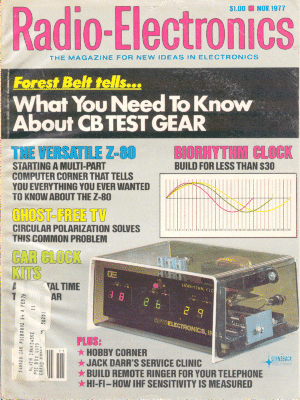
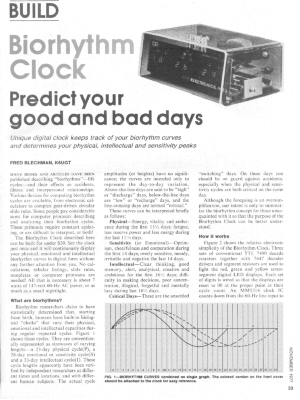
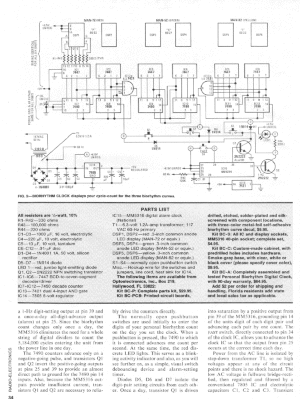
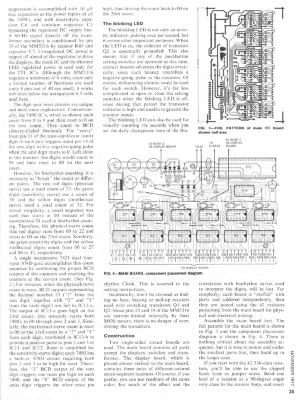
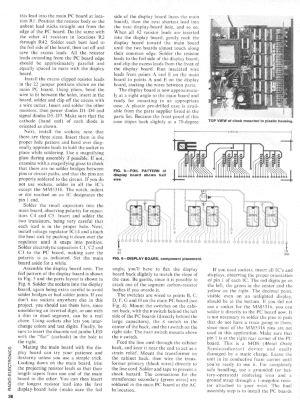
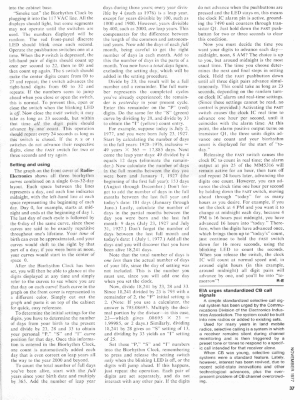
|